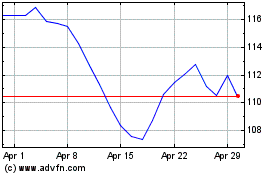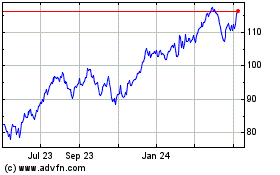Prudential Reprices Some Insurance Products as Lower Rates Weigh on Profits
July 09 2020 - 4:48PM
Dow Jones News
By Mark Maurer
Prudential Financial Inc. planned for a pandemic as severe as
the Spanish flu, modeling for a potential crisis that would be more
severe than the initial coronavirus outbreak suggested. This
prepared the company for some of the financial shocks, such as the
difficulty in preserving capital, but not the ultralow interest
rates.
Ken Tanji, chief financial officer of the Newark, N.J.-based
life insurer, is helping lead the effort to combat interest-rate
pressure on corporate profit by boosting prices of insurance
products sold to both plan sponsors and individuals.
"Interest rates have changed pretty substantially in a short
period of time, so making sure we adjust for that is a priority,"
he said.
After the Federal Reserve in March cut rates to nearly zero, in
an effort to stimulate the economy, life insurers were faced with
investing in bonds that have lower yields than bonds in their
existing portfolios, denting their investment income. Typically,
insurers generate income from investing in higher-yielding
assets.
The company's operating income fell 25% in the first quarter to
$939 million, Prudential reported in May. The group-insurance
division's earnings also sank with lower variable investment
income.
Sales will likely slow on some of the faster-growing products
such as pension risk transfers, in which companies purchase an
annuity to remove a defined-benefit plan from their books, because
low interest rates have made the terms less attractive, said Rajiv
Bhatia, an analyst at Morningstar Inc.
In recent months, Mr. Tanji has sought to make product changes
to ensure adequate returns and address customers' needs. Despite
raising prices, the company has allowed customers to waive
withdrawal fees on some products and, for low-income clients, tried
to make more products accessible. Mr. Tanji said he works closely
with actuaries and the investment and product-development teams to
make pricing decisions.
Mr. Tanji also is focused on redesigning insurance products that
saw profits fall due in part to lower rates. The company has said
it is pivoting toward lower risk and less capital-intensive
products.
For example, Prudential is looking to sell more buffered
annuities that offer a guaranteed minimum of return on top of any
market returns. Buffered annuities are more appealing to customers
during a period of market volatility, in part because the return
doesn't hinge on the stability of the market. In May, Prudential
unveiled a buffered annuity called FlexGuard.
Additionally, changes to the individual life-insurance business
will lead to more products that are less dependent on interest
rates, Mr. Tanji said.
The company also is trying to protect against profit declines by
continuing to cut operating expenses and expanding its distribution
of insurance products through Assurance IQ, an online insurance
platform it acquired in October, Mr. Bhatia said.
When the pandemic began spreading in the U.S. in March, Mr.
Tanji helped lead efforts to boost liquidity. The company issued
$1.5 billion in debt to cover its debt maturities through 2021.
"As much as it's been difficult, there have been a lot of
positives," Mr. Tanji said. "The role that finance plays in times
like this is more important than ever."
Write to Mark Maurer at mark.maurer@wsj.com
(END) Dow Jones Newswires
July 09, 2020 16:33 ET (20:33 GMT)
Copyright (c) 2020 Dow Jones & Company, Inc.
Prudential Financial (NYSE:PRU)
Historical Stock Chart
From Mar 2024 to Apr 2024

Prudential Financial (NYSE:PRU)
Historical Stock Chart
From Apr 2023 to Apr 2024
